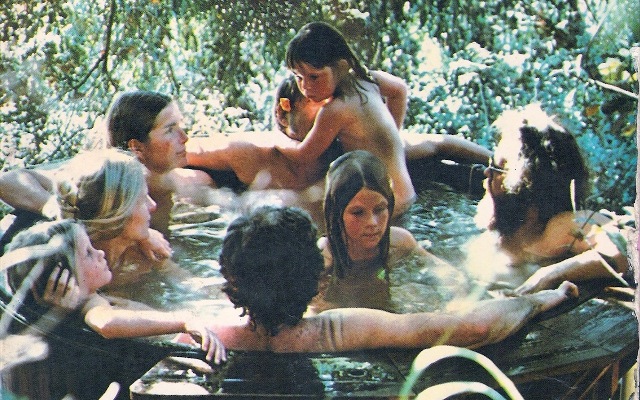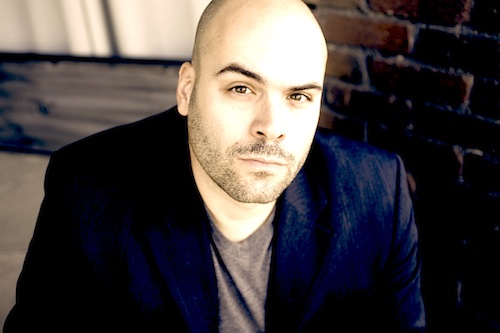Hot Tubs
An Interview with Gabe Rosenn

Gabe Rosenn makes his directorial debut in Hot Tubs. The film takes a look into the hot tub culture of Mountain Drive, a neighborhood tucked away in the mountains of Santa Barbara. Despite the chaotic times of the 1970s, the locals of Mountain Drive partied on, letting even their clothes come off in the hot tub. Rosenn incorporates archival footage, photographs, and interviews to tell the story that led to the rise of the modern day spa.
According to Rosenn, the film explores not only the wild side of hot tubs in the ’70s, but also deals with both the spiritual and healing aspect of the hot tub. While inspired by the book of the same title written by Noel Young, the film is dedicated to Fred Carr, remembered as the poster boy for the hot tub craze, who died of lung cancer just three months after being interviewed for the film.

The film covers an unusual topic — how was it originally conceived?
The film is an adaptation and exploration of the book Hot Tubs by Noel Young. The film looks at the culture in the ’70s, and the book that gave rise to the spa industry.
When I was 16, I had the book. [My dad and I] wanted to build a hot tub. I always got a kick out of it. I was the class cartoonist, so I was drawn to the book’s cartoons. When I moved out to California I was working on a documentary series; when the job ended I thought it was the perfect time to check out Mountain Drive. The book was a really warm portrait of that community and that lifestyle. As a teen my friends and I always got a kick out of it … it’s a funny book. I’m excited that the film is done and in the festival.
How exactly did the book give rise to the spa industry?
All these people in the book lived on Mountain Drive and had hot tubs they built out of wine vats. The book was a runaway hit. Random House took it over on the East Coast. All these people started calling Noel Young, asking ‘How do I get one?’ ‘How do I build one?’ It launched a hot tub craze in the country. Suburban people were building wooden hot tubs in their backyards. The movie tells the story of how the jacuzzi put the redwood hot tub out of business.
How did you go about obtaining permission to use the book?
I contacted Noel’s company, Capra Press, and they put me in touch with Young’s ex-wife, Judith Young, who is one of the stars of the movie. Judy put me in touch with Leslie Westbrook, Dick Johnston, Wayne McCall… Each of these people kept putting me in touch with new people, and I put an ad out. Over the course of 18 months, the whole thing unfolded in front of me. I thought Noel would be alive and kicking; I was surprised and sad that he had passed away. But Judith was very helpful in helping me track down people.
One of the major challenges of making the piece was locating archival footage from that time. A lot of people didn’t shoot anything at hot tub parties — it was un-cool. The Tea Fire was a major problem, destroying old homes on Mountain Drive, the exact place I wanted to document. A lot of people I wanted to talk to were displaced. I didn’t want the piece to be about the fire. I wanted to focus on the book and that more idealized time. The film looks back and doesn’t deal with present time as much. It was a hard time up there, and I didn’t really feel comfortable documenting it.
A lot of people had some footage from [The Original Santa Barbara Hotub Company] promotional films. Some footage I shot myself, using Super 8 footage to make it look old. There were a lot of photos from the book. I got permission from the three photographers, who were amazing, to use them — a major help. Sources worked together, interviews were shot on normal digital video.
One interesting piece about this, the film uses music from that time. The music was something that I really paid attention to. My band and I recorded music — Led Zeppelin, Eric Clapton, The Meters, The Band. We replicated that music, to re-create the feel of that ’70s time.
Are there any funny hot tub stories worth sharing?
Yeah, tons. Some of the tubs were in Isla Vista, like the Cuddle Tub. It was really small, meant for two people. That’s why the book was funny — all the tubs were named. There was the Boulder Pool, made of boulders, and the Cannibal Pot. It shows you how unique and funny the whole thing was — a really handmade thing. These guys made their own tubs — it was really unique.
There were a lot of stories that didn’t get the cut. The cut is short, 24 minutes. It was meant to be a feature but, like I said, it was hard to get archival footage.
Fred Carr invented the hot tub kit — once people called Noel, he redirected them to Fred — and that started the hot tub industry. A lot of parties were going on, different from parties we have now. Jim Bartelman talks about how parties could go on for days. Fred tells this story of how a pro basketball team came to hang out and they all ended up naked in the hot tub — it was the ’70s. He didn’t specify what team. No one had a car, so they got on horses to go across town to Montecito to another hot tub party. Just the idea of huge basketball players naked on horses is funny, but it shows you what a different time it was it. I can’t imagine that in modern day Santa Barbara, where you get a ticket for jaywalking.
Jim Bartelman, also a hot tub maker, told the story of how they used to put salt in the hot tubs, where it would be like the Dead Sea so you could just float. They would put on trippy music. Sounds like a pretty crazy time.
Does the film have a specific message?
Yeah totally, the film is meant to, quote: ‘Spread warmth and trust in a suspicious and overcrowded world.’ That’s the dedication of the book and film. That’s Noel Young’s quote. And maybe to start a hot tub renaissance in Southern California, not to be too ambitious.
4•1•1
Hot Tubs screens on February 1 at 8 p.m. in the Metro 4 Theatre, and February at 10:30 p.m. in the Metro 4 Theatre. The schedule is subject to change, so see independent.com/sbiff for updates.



